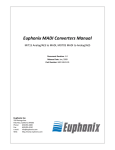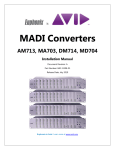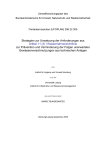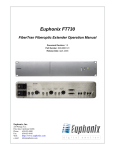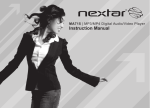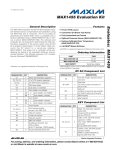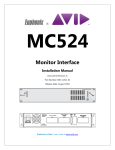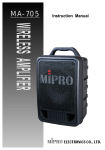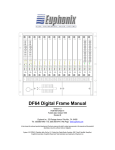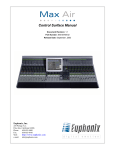Download Euphonix MADI MO705 Installation manual
Transcript
MI715 MO705 MADI Converters Installation Manual Document Revision: A Part Number: 840-11314-01 Release Date: August 2010 Euphonix is Avid. Learn more at www.avid.com Regulatory and Safety Notices FCC Notice Part 15 of the Federal Communication Commission Rules and Regulations has established Radio Frequency (RF) emission limits to provide an interference free radio frequency spectrum. Many electronic devices produce RF energy incidental to their intended purpose. These rules place electronic equipment into two classes, A and B, depending on the intended use. Class A devices are those that may be expected to be installed in a business or commercial environment. Class B devices are those that may be expected to be installed in a home or residential environment. The FCC requires devices in both classes to be labeled with the interference likelihood and additional operating instructions. The rating label on the equipment will show which class the product is (A or B). Class A product will not have an FCC logo. Class B equipment will have an FCC logo. The information statements differ on the two classes. Class A Equipment This equipment has been tested and found to comply with the limits for a Class A digital device, pursuant to Part 15 of the FCC rules. These limits are designed to provide reasonable protection against harmful interference when the equipment is operated in a commercial environment. This equipment generates, uses, and can radiate radio frequency energy and, if not installed and used in accordance with the instructions, may cause harmful interference to radio communications. Operation of this equipment in a residential area is likely to cause harmful interference, in which case the user will be required to correct the interference at personal expense. Euphonix is Avid. Learn more at www.avid.com Modifications The FCC requires the user to be notified that any changes or modifications made to Avid hardware that are not expressly approved by Avid Technology may void the user’s authority to operate the equipment. Cables Connections to Avid hardware must be made with shielded cables with metallic RFI/EMI connector hoods in order to maintain compliance with FCC Rules and Regulations. PRODUCTS WITH MULTIPLE POWER INPUTS: WARNING: Each power input is intended to be connected to a separate branch circuit. Risk of high leakage exists if multiple inputs are connected to a single source and protective earth is not present. A QUALIFIED SERVICE PERSON shall verify that each socket-outlet from which the equipment is to be powered provides a connection to the building protective earth. If any do not provide this connection, the QUALIFIED SERVICE PERSON shall arrange for the installation of a PROTECTIVE EARTHING CONDUCTOR from the separate protective earthing terminal to the protective earth wire in the building. Canadian ICES-003 Class A Equipment This Class A digital apparatus meets all requirements of the Canadian Interference-Causing Equipment Regulations. Cet appareil numérique de la classe A respecté toutes les exigences du Règlement sur le matériel brouilleur du Canada. Euphonix is Avid. Learn more at www.avid.com European Union Declaration of Conformity Declaration of conformity Konformitätserklärung Déclaration de conformité Declaración de Confomidad Verklaring de overeenstemming Dichiarazione di conformità We/Wir/ Nous/WIJ/Noi: Avid Technology 1925 Andover Street Tewksbury, MA, 01876 USA European Contact: Nearest Avid Sales and Service Office or Avid Technology International B.V. Sandyford Industrial Estate Unit 38, Carmanhall Road Dublin 18, Ireland declare under our sole responsibility that the product, erklären, in alleniniger Verantwortung,daß dieses Produkt, déclarons sous notre seule responsabilité que le produit, Euphonix is Avid. Learn more at www.avid.com declaramos, bajo nuestra sola responsabilidad, que el producto, verklaren onder onze verantwoordelijkheid, dat het product, dichiariamo sotto nostra unica responsabilità, che il prodotto, Product Name(s) : MADI Converters Model Number(s): MI715 & MO705 Product Options: This declaration covers all options for the above product(s). to which this declaration relates is in conformity with the following standard(s) or other normative documents. auf das sich diese Erklärung bezieht, mit der/den folgenden Norm(en) oder Richtlinie(n) übereinstimmt. auquel se réfère cette déclaration est conforme à la (aux) norme(s) ou au(x) document(s) normatif(s). al que se refiere esta declaración es conforme a la(s) norma(s) u otro(s) documento(s) normativo(s). waarnaar deze verklaring verwijst, aan de volende norm(en) of richtlijn(en) beantwoordt. a cui si riferisce questa dichiarazione è conforme alla/e seguente/i norma/o documento/i normativo/i. The requirements of the European Council: Safety: Directive 2006/95/EC EN 60065:2002 /A1:2006 EMC: Directive 2004/108/EC EN 55103-1:1996 EN 55103-2:1996 Euphonix is Avid. Learn more at www.avid.com LED Safety Notices Avid hardware might contain LED or Laser devices for communication use. These devices are compliant with the requirements for Class 1 LED and Laser Products and are safe in the intended use. In normal operation the output of these laser devices does not exceed the exposure limit of the eye and cannot cause harm. Standard to which conformity is declared: (IEC 60825-1) Optical connections are located on the rear panel and are typically labeled “Optical” or “SPDIF/ADAT.” The exact location of optical connections is identified more clearly elsewhere in the documentation for the Avid hardware device. Disposal of Waste Equipment by Users in the European Union Euphonix is Avid. Learn more at www.avid.com Rack-mount Requirements The following rack-mount requirements are listed below: • Elevated Operating Ambient — If installed in a closed or multi-unit rack assembly, the operating ambient temperature of the rack environment might be greater than room ambient. Therefore, consider installing the equipment in an environment compatible with the maximum ambient temperature (Tma) specified by the manufacturer. • Reduced Air Flow — Installation of the equipment in a rack should be such that the amount of air flow required for safe operation of the equipment is not compromised. Do not block vents. • Mechanical Loading — Mounting of the equipment in the rack should be such that a hazardous condition is not achieved due to uneven mechanical loading. • Circuit Overloading — Consideration should be given to the connection of the equipment to the supply circuit and the effect that overloading of the circuits might have on overcurrent protection and supply wiring. Appropriate consideration of equipment nameplate ratings should be used when addressing this concern. • Reliable earthing — Reliable earthing of rack-mounted equipment should be maintained. Particular attention should be given to supply connections other than direct connections to the branch circuit (for example, use of power strips). Euphonix is Avid. Learn more at www.avid.com Lithium Battery Replacement If a battery is supplied in this Avid product it must only be replaced by qualified personnel. Contact Avid Customer Support for assistance. WARNING Danger of explosion if battery is incorrectly replaced. Replace with only the same or equivalent type recommended by the manufacturer. Dispose of used batteries according to the manufacturer’s instructions. ADVARSEL! Lithiumbatteri - Eksplosionsfare ved fejlagtig håndtering. Udskiftning må kun ske med batteri af samme fabrikat og type. Levér det brugte batteri tilbage til leverandøren. ADVARSEL! Lithiumbatteri - Eksplosjonsfare. Ved utskifting benyttes kun batteri som anbefalt av apparatfabrikanten. Brukt batteri returneres apparatleverandøren. VARNING Explosionsfara vid felaktigt batteribyte. Använd samma batterityp eller en ekvivalent typ som rekommenderas av apparattillverkaren. Kassera använt batteri enligt fabrikantens instruktion. VAROITUS Paristo voi räjähtää, jos se on virheellisesti asennettu. Vaihda paristo ainoastaan laitevalmistajan suosittelemaan tyyppiin. Hävitä käytetty paristo valmistajan ohjeiden mukaisesti. Euphonix is Avid. Learn more at www.avid.com Euphonix MADI Converters Operation Manual Table of Contents Chapter 1: Introduction ..................................................................................................... 4 1.1 MI715/MO705......................................................................................... 4 1.2 Power On Sequence ................................................................................. 5 1.3 Safety and Precautions............................................................................ 5 1.3.1 Chapter 2: 220, 230, 240 VAC Operation..................................................... 5 MI715 and MO705 Converters .................................................................. 7 2.1 Features.................................................................................................... 7 2.2 Applications............................................................................................. 7 2.3 MI715/MO705 Front Panel ...................................................................... 8 2.4 MI715 Rear Panel ..................................................................................... 9 2.5 MO705 Rear Panel ................................................................................. 11 2.6 Synchroniztion........................................................................................12 2.7 2.6.1 MI715 ...................................................................................... 12 2.6.2 MO705 ..................................................................................... 12 Specifications ......................................................................................... 13 v Euphonix MADI Converters Operation Manual Chapter 1: Introduction 1.1 MI715/MO705 The MI715 and MO705 converters provide MADI conversion to interface to/from analog and AES equipment such as consoles, tape decks, microphone preamplifiers and other devices. Both converters are two rack spaces high and are housed in a stain‐ less steel chassis with machined, heavy aluminum front panels. The MI715 converts incoming analog signals to 24‐bit MADI digital signals that capture the input’s complete dynamic range. Each main AES/EBU input is automatically evaluat‐ ed for sample‐rate conversion. The incoming sample rate is compared with the internal rate. If they are the same, no conversion occurs. If the rates differ, sample‐rate con‐ version is activated and persists until a new input is applied or the internal sample rate changes. The sample‐rate conversion range is 32–56 kHz.In addition to the 8 XLR con‐ nectors for analog inputs and 8 XLR connectors/2 D‐Sub connectors for AES inputs. The MO705 converts incoming MADI signals to 8 analog channels and 8 AES stereo pairs. The 16 digital outputs (8 pair) can be bit-depth converted from 24 to 20 or 16 bits. 4 Euphonix MADI Converters Operation Manual 1.2 Introduction Power On Sequence We recommend powering up the converters only after verifying the presence of a valid sync signal. After powering up the converters, the Sample Rate and Sample Rate Source LEDs blink as the converter senses the incoming Sample Rate source and Sam‐ ple Rate. We recommend monitoring the power‐up sequence to verify the converters have correctly auto‐sensed the desired Sample Rate Source and Sample Rate. 1.3 Safety and Precautions The MI715 and MO705 comply with CE’s EN 60950 Electrical Safety Standards. 1.3.1 220, 230, 240 VAC Operation NOTE: Before connecting power to the converters, change the fuse and voltage selector to the appropriate 220/230/240 VAC settings. The converters preserve their signal quality using linear power supplies that must be manually switched between 115 and 230 VAC. The units are shipped set for 115 VAC. Move the red, two‐position switch near the power entry module of the converters to the 230 VAC position (down) for 220/230/240 VAC operation. Each unit uses a 0.630 A fuse for 115 VAC operation. To operate at 220, 230, or 240 VAC, install the spare 0.315 A fuse provided in the power entry module fuse‐holder. To access both the active and the spare fuse: 1. Turn the unit’s power off. 2. Remove the IEC power cable from the power entry module. 3. Use a small screwdriver to open the fuse tray below the electrical inlet. The active fuse is to the rear of the tray. The spare fuse is in the tray slot clos‐ est to the front. Pull the fuses through the plastic constriction point that holds them from falling out. NOTE: Never disconnect the safety ground to the converters. 5 Euphonix MADI Converters Operation Manual Introduction Power Cord Requirements The converters are supplied with North American IEC power cords. If this cord is changed to allow a different plug configuration, it is the responsibility of the user to select an approved power cord with proper construction material, current capacity, flexibility, and strength characteristics. Cooling We strongly recommend providing adequate ventilation to the converters, particular‐ ly when installed in a rack. The MI715 and MO705 converters in particular should have space left above and below every two units so heat can properly dissipate 6 Euphonix MADI Converters Operation Manual Chapter Ϯ: MI715/MO705 Converters Features Professional grade audio conversion is accomplished utilizing 128 times over‐sampled noise‐shaped delta‐sigma techniques. The analog to digital conversion employs a multi‐bit modular architecture while the digital to analog conversion employs a single‐ bit modulator architecture. Low‐jitter reference clocks are provided utilizing digital PLL techniques with VCXO and VCO oscillators. The analog inputs and outputs can be calibrated from the front panel of each unit. AES/EBU and Word Clock external sync inputs on both units provide synchronization to digital systems. Sample Rate Source and Sample Rate are automatically sensed by both units. Supported sample rates include 44.1, 48, 88.2, and 96 kHz. In addition, pull‐ up and pull‐down rates for the standard sample rates, as well as custom sample rates are available. Ϯ.Ϯ A pplications In addition to their standard use in a Euphonix digital system, the MI715 and MO705 can be used as stand‐alone converters. When used with the Euphonix SH612 Studio Hub, this is a powerful conversion and MADI routing system that can be used to inter‐ face between an analog console and an otherwise all‐digital facility (i.e., TV broadcast facility). NOTE: MADI cables can be extended to 50 m (164 ft), allowing remote location of the con‐ verters. 7 Euphonix MADI Converters Operation Manual Ϯ.ϯ MI715/MO705 Converters Features MI715/MO705 Front Panel This section discusses both front panels and notes their few differences. Trim Pots Access: One trim pot adjuss the maximum analog input/output level of channels 1–8 in 2‐dB steps between +12 and +26 dBu. Sample Rate LEDs: These LEDs indicate the sample rate to which the converter is cur‐ rently locked. Sample rates are auto‐sensed but can be manually selected on the AM713. Supported sample rates are 96 kHz, 88.2 kHz, 48 kHz, 44.1 kHz, and Custom rates from external sources. Sample Rate Source LEDs: These LEDs indicate the format of the Sample Rate Source to which the converter is currently locked. Sample Rate Source can be auto‐sensed or manually selected. If an external source is not detected, the MI715 reverts to Internal sync; the MO705 mutes its outputs. If a manually selected source is not present, the Sample Rate Source indicator blinks. • AES: Sample Rate locked to AES Input. • Word: Sample Rate locked to Word Clock Input. • Internal (MI715 only): Sample Rate locked to its own internal crystal. • MADI (MO705 only): Sample Rate locked to MADI. • Auto: Sample Rate Source has been auto‐sensed. These LEDs appear in the same order in which signals are tested for their presence. This detection procedure occurs when the converters are powered on. The Sample Rate (MI715 only) and Sample Rate Source can also be selected manually.Manual Se‐ lection Buttons: The button below each Sample Rate LED row manually selects the sample rate. The MI715 also allows manual selection of the Sample Rate Source. Power Switch: On/Off switch. NOTE: There are no user‐serviceable parts in the converters. 8 Euphonix MADI Converters Operation Manual Ϯ͘ϰ MI715/MO705 Converters Features MI715 Rear Panel MA715 Rear Panel Input Voltage Selector: This red switch allows the unit to operate in either 110/115 VAC or 220/230/240 VAC environments. A fuse must also be changed for 220/230/240 VAC operation (see page 5). Units are shipped set and fused for 110/115 VAC. Power Connector (IEC) and Fuse Tray: The IEC power connector accepts standard IEC power cords. The fuse tray contains both the active fuse and a spare fuse for 220/230/ 240 VAC operation. See page 6 for instructions on how to change the fuse for 220/ 230/240 VAC operation. Analog Inputs (female XLR): 8 balanced, analog inputs on XLR connectors. Input sen‐ sitivity is set from the front panel. AES/EBU Digital Input (female XLR): 8 Stereo AES/EBU digital input on XLR connectors Parallel AES/EBU Digital Inputs (female DB25): Two 8‐channel digital connectors function in parallel with XLR digital inputs, and should not be used simultaneously AES Sync In (female XLR): Master clock input for the converter when using AES as Sam‐ ple Rate Source. AES Sync Thru (male XLR): Outputs the same signal connected to AES Sync In. Word In (BNC): Master clock input for the converter when using Word Clock as Sam‐ ple Rate Source. Word Out (BNC): Outputs a Word clock signal synchronized to the Sample Rate Source. In the presence of an external Word clock input, this connector provides a regenerated version of that input signal. Without an external sample rate source, this connector outputs the internally generated clock signal. 9 Euphonix MADI Converters Operation Manual MI715/MO705 Converters Features MADI Out (BNC): Outputs the digital audio signal. • 1–8: Analog inputs • 9–24: AES inputs 10 Euphonix MADI Converters Operation Manual Ϯ͘ϱ MI715/MO705 Converters Features MA705 ReaƌPanel Figure 1-1 MA705 Rear Panel Input Voltage Selector: This red switch sets the unit to either 110/115 VAC or 220/ 230/240 VAC environments. A fuse must also be changed for 220/230/240 VAC oper‐ ation (see page 6). Units are shipped set and fused for 110/115 VAC. Power Connector (IEC) and Fuse Tray: The IEC power connector accepts standard IEC power cords. The fuse tray contains both the active and spare fuses. See page 6 to learn how to change the fuse for 220/230/240 VAC operation. Analog Outputs (male XLR): 8 balanced analog outputs on XLR connectors. Output lev‐ el is set from the front panel. AES/EBU Digital Outputs (male XLR): 8 Stereo AES/EBU digital outputs on one XLR connector. Parallel AES/EBU Digital Outputs (female DB25): Two 8‐channel digital connectors function in parallel with XLR digital outputs and the two outputs should not be used simultaneously. See Figure 3‐5 on page 33 for pinout diagram. AES Sync In (female XLR): Master clock input for the converter when using AES as the Sample Rate Source. AES Sync Thru (male XLR): Outputs the same signal connected to AES Sync In. Word In (BNC): Master clock input for the converter when using Word Clock as Sam‐ ple Rate Source. Word Out (BNC): Outputs a Word Clock signal synchronized to the Sample Rate Source. In the presence of an external Word clock input, this connector provides a regenerated version of the input signal. Without an external sample rate source, this connector outputs an internally generated clock signal. MADI In (BNC): Digital audio signal input. • 1–8: analog outputs • 9–24: AES outputs 11 Euphonix MADI Converters Operation Manual MI715/MO705 Converters Features Ϯ͘ϲSynchronization Ϯ͘ϲ.1 MI715 The MI715’s Sample Rate is set externally by one of two source signals or internally by crystals and associated circuitry. The Sample Rate Source is determined automatically by the presence of signals when the MI715 is powered on. The order in which external signals are tested for presence is: AES, Word, Internal. The detected signal immediately becomes the source for the MI715’s sample rate clock. The auto‐sensed Sample Rate Source can be overridden using the button on the front panel of the MI715, below the Sample Rate Source LEDs. If neither AES nor Word Clock signals are present, the MI715 uses its internal clock derived from on‐board volt‐ age‐controlled crystal. The default internal Sample Rate of the MI715 is 48 kHz. This default internal rate can be overridden with the Sample Rate button on the front panel of the MI715 (directly below the Sample Rate LEDs) to 44.1, 48 or 96 kHz. Ϯ͘ϲ.2 MO705 The MO705 detects Sample Rate and Sample Rate Source like the MI715 with the following two differences: • Since the MO705 is always a slave to an external Sample Rate Source, there is no internal Sample Rate setting. • The MO705 can use MADI in addition to AES or Word Clock as a Sample Rate Source, and detects the presence of these signals in the following order: AES, Word, MADI. When a signal is detected, it immediately becomes the sample rate clock of the MO705. The auto‐sensed Sample Rate Source can be overridden with the Sample Rate Source button on the front panel of the MO705, below the Sample Rate Source LEDs. 12 Euphonix MADI Converters Operation Manual 2.7 MI715/MO705 Converters Features Specifications MI715 Performance Specifications Sync Sources AES, word clock, internal Sync Outputs AES thru and word clock out Sync Detection Auto or switched Internal Sample Rate 44.1, 48, 88.2, 96 kHz ±50 ppm Lock range fine mode custom mode 300 ppm 12% varispeed of 44.1 and 48 kHz Above 50 kHz, varispeed can adjust the nominal sample rate by -12 to +5% 8 analog, 16 AES (8 AES Pairs) Audio Inputs Analog Inputs (1–8) Electronically balanced XLR; 20 k input impedance Level for 0 dBFS Signal-to-Noise Ratio THD Frequency Response (1 kHz @ +4 dBu) CMRR Crosstalk Group Delay Adjustable between +12 and +26 dBu in 2-dB steps 105 dB (unweighted) 0.0005% 0.25 dB 20 Hz – 20 kHz @ 48 kHz -2.5 dB 20 Hz – 40 kHz @ 96 kHz >50 dB 20 Hz – 20 kHz -110 dB @ 1 kHz -100dB 20 Hz – 20 kHz 41.7/Fs (869 s @ 48 kHz) AES Inputs (9-24) XLR, transformer isolated, 110 , 24-bit Group delay varies with sync frequency and inputs MADI Output BNC 75 24 channels at all sample rates Inputs mapped to channels 1–24, 24-bit signal path 13 Euphonix MADI Converters Operation Manual MI715/MO705 Converters Features MO705 Performance Specifications Sync Sources AES, word clock, MADI Sync Outputs AES thru and word clock out Sync Detection Auto or switched Internal Sample Rate 44.1, 48, 88.2, 96 kHz ±50 ppm Lock range fine mode custom mode 300 ppm 12% varispeed of 44.1 and 48 kHz Above 50 kHz, varispeed can adjust the nominal sample rate by -12 to +5% MADI Input BNC 75 44.1/48 kHz: 56 channels 88.2/96 kHz: 28 channels. Outputs mapped to channels 1–24, 24-bit signal path Audio Outputs 8 analog,16 AES Analog Outputs (1–8) Electronically balanced XLR; 200 output impedance Level for 0 dBFS Signal-to-Noise Ratio THD Frequency Response (1 kHz @ +4 dBu) CMRR Crosstalk Group Delay AES Outputs (9–24) Truncation Type Dither Type Digital Format Group Delay Adjustable between +12 and +26 dBu in 2-dB steps 101 dB (unweighted) 0.0003% 0.25 dB 20 Hz – 20 kHz @ 48 kHz -2.5 dB 20 Hz – 40 kHz @ 96 kHz >50 dB 20 Hz – 20 kHz -110 dB @ 1 kHz -100 dB 20 Hz – 20 kHz 28.2/Fs (588 s @ 48 kHz) AES on XLR, transformer isolated, 110 , 24 bit User can truncate to 16- or 20-bit per stereo pair Dithered or 1st order noise-shaped, internally switched TPDF (active only for 16- or 20-bit word length) Pro or Consumer, internally switched 3/Fs (63 μs @ 48 kHz) AES (XLR), transformer isolated, 110 . Digital Format professional or consumer (internally switched) 14 Euphonix MADI Converters Operation Manual MI715/MO705 Converters Features IM715/MO705 Technical Specifications Power Requirements 101 VAC or 2240 VAC; 5060 Hz Power Consumption$ Temperature of Operation 5–35C Dimensions Height: 3.5 in; Width: 19 in; Depth: 18.25 in; Weight: 17 lb 15 In the interest of continued product development, Euphonix reserves the right to make improvements in this manual and the product it describes at any time, without notice or obligation. System 5, S5, PatchNet, eMix, EuCon, R1, Studio Hub, Audio Deck, Max Air, Reel Feel, Clear Displays, Track Panner, SnapShot Recal, DSC (Digital Studio Controller), HyperSurround, Total Automation and Mix View are trademarks of Euphonix, Inc. ©2009 Euphonix, Inc. All rights reserved worldwide. No part of this publication may be reproduced, transmitted, transcribed, stored in a retrieval system, or translated into any language in any form by any means without written permission of Euphonix, Inc. Manual written by Jay Spears and Eddie Jones Note: This equipment has been tested and found to comply with the limits for a Class A digital device pursuant to Part 15 of the FCC Rules. These limits are designed to provide reasonable protection against harmful interference when the equipment is operated in a commercial environment. This equipment generates, uses, and can radiate radio frequency energy and, if not installed and used in accordance with the instruction manual, may cause harmful interference to radio communications. Operation of this equipment in a residential area is likely to cause harmful interference in which case the user will be required to correct the interference at his own expense. Caution: Any changes or modifications made by the user that are not expressly approved by Euphonix could void the user’s right to operate the equipment.






















